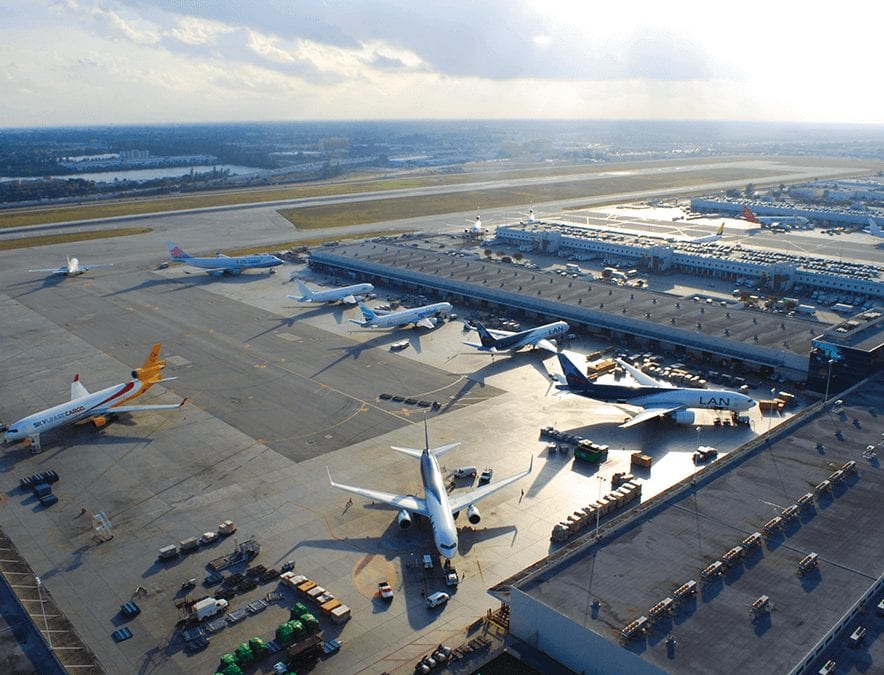As increased cut-flower shipments arrive daily at Miami International Airport (MIA), the airport continues to strengthen its established reputation as the premier floral gateway in the U.S. for flowers exported worldwide. Cut flowers represent MIA’s top import commodity, with 2018 airport statistics reporting that 88.7 percent of all U.S. cut-flower imports – a total of 231,046 tons of flowers – were transported in and out of MIA. Overall, total flower shipments have increased by 3 percent since 2017, due to growing consumer/market demands.
“Airport and seaport facilities report increased cut flower shipments from global locations.”
Founded in 1928, Miami International Airport currently sits on 3,230 acres in Miami-Dade County. As the largest of the five airports operated by the Miami-Dade Aviation Department, it boasts a lineup of more than 100 air carriers and is the top U.S. airport for international freight. The airport and related aviation industries contribute 270,681 jobs directly and indirectly to the local economy. MIA is also the leading economic source for Miami-Dade County and the state of Florida, generating business revenues of $30.9 billion annually. With such an impressive résumé, MIA is often seen as the first and only choice for shipments of time- and temperature-sensitive flowers bound for the consumer market. According to statistics from the Association of Floral Importers of Florida(AFIF), approximately 40,000 boxes of flowers arrive at MIA each day (more during high-demand periods for flowers such as prior to Valentine’s Day and Mother’s Day), with airport infrastructure designed to maintain the cold chain as the flowers await further travel to their final destinations.
Ernesto Rodriguez, section chief of Marketing at MIA, described the typical process for flowers after they arrive at MIA. “Due to the sensitivity to time, temperature and treatment, the flowers remain at MIA for only a short period before heading to their final destinations,” he said. “Upon arrival, the flowers are offloaded, with no waiting time on the tarmac from the aircraft to the cooling facility; inspected; and transported via trucks to their final destinations.”
The airport maintains floral cold chain and temperatures with 41,910m2 of on-airport refrigerated warehouse space for temperature-controlled products. “There are four types of cooling systems on airport: flowers, fruits and vegetables, seafood, and pharma. These facilities are controlled and maintained by the air carriers and/or cargo handling company that provides the refrigerated warehouse,” Rodriguez explained, adding, “There is not one on-site facility specifically for flowers. However, MIA is home to a USDA Animal & Plant Health Inspection Service (APHIS) Facility, where officers inspect foreign plants that may contain pests or diseases not native to the U.S.”
Several air carriers transport cut flowers in and out of MIA, with the main ones being LATAM Cargo, Avianca Cargo, Amerijet, Atlas, UPS and FedEx. The top five countries exporting cut flowers to Miami are Colombia, Ecuador, Costa Rica, Guatemala and the Netherlands.
As floral statistics continue to increase at MIA, new infrastructure improvement plans look to meet tonnage demands in the coming years. Rodriguez pointed out, “This June, the Miami-Dade County Board of County Commissioners adopted a new capital improvement program at MIA that will fund up to $5 billion in airport-wide modernization projects over the next five to 15 years. This will pave the way for future growth in passenger and cargo traffic at MIA – projected to reach 77 million travelers and more than four million tons of freight by 2040. One of the five sub-programs is dedicated to cargo facility and infrastructure expansion.”
To further enhance its relationship with the floral industry, MIA is looking beyond its “Gateway to the Americas” moniker to online commerce and the growth potential it offers.
“Consumers are now ordering more flowers online. E-commerce is the largest and most important development in logistics today. There is unlimited growth potential in this segment of the supply chain, and MIA is working with its air carriers and community to make sure we are leading the effort in this future growth segment of the industry. We have embarked on developing a new strategy to become the ‘E-commerce Hub of the Americas,’” Rodriguez said.
Just as floral shipments continue to rise at Miami International Airport, so do shipments in and out of PortMiami, a cargo and passenger seaport that is situated less than 10 miles away from MIA. PortMiami, formerly the Dante B. Fascell Port of Miami, encompasses 520 acres and is the largest container port in the state of Florida and the ninth largest in the U.S. While flowers account for only 10 percent of refrigerated business at the seaport, statistics show that from February to April 2019, 34.5 million stems moved through PortMiami – an increase of 1,227 percent over the same time period in 2018.
Unlike the numerous air carriers at MIA that handle flowers, at PortMiami, there are only three carriers that transport flowers, the largest being Seaboard, followed by Maersk/Sealand and CMA-CGM. Most of the flowers moving through the port are coming from Colombia, followed by Guatemala, Ecuador, Mexico and Costa Rica.
Eric Olafson, director of Global Trade & Business Development at PortMiami, said, “We have seen a significant increase thanks to a modal shift from air to sea. There are no problems with tariffs, and Colombia, Costa Rica, Mexico and Guatemala all have free-trade agreements with the U.S.”
Currently, flowers that arrive at PortMiami are transported by truck or rail; however, some industry professionals believe that rail could become a more viable option for domestic transport of floral products. Limited research has shown rail transportation offers a smoother ride for flowers than trucks, creating less overall trauma for the flowers, which could potentially extend vase life as a result.
“Flowers leave the port by both truck and rail,” said Olafson. “There was a pilot trial where flowers came into MIA via air and then were transported via rail to Chicago. The customer said the condition of the flowers was better than those shipped by truck because the rail ride is smoother. Thus, we predict more flowers will travel via rail in the future.” With two sites at the seaport where flowers can be processed, PortMiami maintains cold chains and temperatures the old-fashioned way of leaving the refrigerated boxes closed and not exposing the flowers to outside air.
When asked what the future holds for the floral industry and transport through PortMiami, Olafson summed up, “We expect continued growth. At present, 40 percent of the flowers coming into PortMiami come from Colombia, with roses, carnations and lilies being the top flowers flowing in for Valentines Day. Both Valentine’s Day and Mother’s Day are the top holidays in which Miami-Dade County sees an enormous amount of flowers pass through Miami International Airport and now, to a lesser but important extent, PortMiami.”
He added, “The flowers arrive at port, are prioritized for inspection by CBP (U.S. Customs and Border Protection) and sent to Miami-Dade’s state-of-the-art warehouses, which process the flowers for shipping to the U.S. and Canada. Not only are we shipping in flowers during holidays such as Valentine’s Day but we also are importing them year-round, hoping that lower transportation costs can increase the consumption of flowers in the U.S., helping to increase production and jobs in both Latin America and Miami.”
Olafson suggested that significant increases in flower imports via ocean transportation “demonstrate that importers are choosing Miami as their destination because the city has the capacity, the refrigerated warehouses, the professionals and the best experience in the floral industry to receive imported flowers – either via air or sea – process them and send them to the entirety of the United States and Canada.”
Historical Growth of Imports
2015 – 200 stems
2016 – 4,665 stems
2017 – 50,572 stems
2018 – 26,824,910 stems
2019:
January – 14,299,474 stems
February – 6,377,641 stems
March – 4,418,230 stems
April – 23,786,375 stems*
* PortMiami imported almost as many stems in April 2019 than in the entire year of 2018.
• In 2018, PortMiami imported a total of 26.8 million flower stems from six countries. In 2019, during January alone, the port imported 14.3 million flower stems (more than half of 2018’s total).
• During 2018, flowers from Colombia represented 39 percent of flowers that arrived at PortMiami. This made Colombia the biggest exporting country in this category for PortMiami. For only the month of January 2019, Colombia produced 60 percent of the flower stems imported through PortMiami.
• In January 2018, PortMiami received 72,552 flower stems from Colombia, and in January 2019, PortMiami handled 8.6 million flower stems from Colombia, a 119-fold increase in one year.
• The flower types imported in the greatest quantities from Colombia through PortMiami from January 2018 through January 2019 are:
1. Roses – 34 percent
2. Dianthus – 18 percent
3. Alstroemeria – 13 percent









